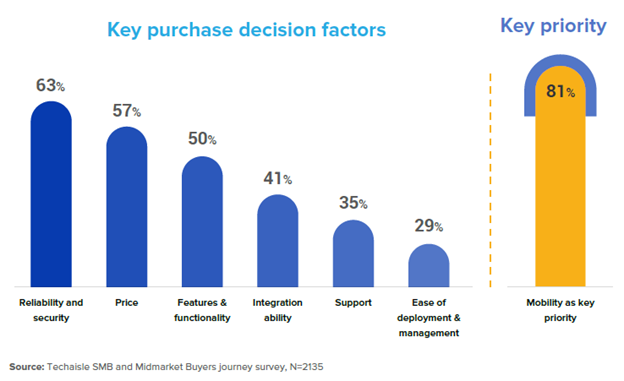Historically, remote work solutions have been the domain of large enterprises equipped with processes and technology resources needed to support workers in the field. However, driven by short- and longer-term factors, flexible work options are now available to employees in businesses of all sizes. Moreover, as social distance health requirements forced the temporary closure of public office spaces, remote work became a matter of survival for many organizations. The pandemic has also crystalized recognition of the productivity benefits of technology-enabled remote work – measured in output rather than hours – which is sure to have a profound and durable impact on workplace behaviors. Today, working from anywhere is the new normal, enabled by powerful communication and collaboration tools, which draw together workers regardless of physical location and are becoming the catalyst for change in large and smaller businesses. What are the primary enablers of this flexible work trend? Data shows a growing commitment to leveraging the power of the cloud and adjacent technologies of mobility, cloud calling, and collaboration - technologies that allow workers and teams to connect, reflect, and share insights and output. Techaisle SMB and Midmarket Hybrid work and collaboration adoption survey, N=1810, shows that:
- 93% of SMBs have prioritized remote and hybrid workplace technology solution adoption
- 58% of employees in the SMB segment are likely to work remotely
- 79% of SMBs are prioritizing cloud-based communication and collaboration solutions which show evolving recognition of the value of cloud calling and collaboration
The simultaneous commitment to cloud calling and collaboration solutions and future planning around a return to the office suggest that something deeper is at play in the SMB communications solution marketplace. Cloud calling and Collaboration are central components of virtually all SMB business activities. The need to communicate anywhere, anytime also means any type of communication and collaboration – synchronous/asynchronous, serendipitous/scheduled, on-the-go/fixed location, within a virtual workspace/within a specific app, with employees/partners/customers. As the lines of demarcation between tasks have been eroded by the increased pace and changing nature of business activities, SMBs have moved past linking discrete actions through linear, sequential processes. Instead, in today's business environment, SMBs interact at all points in the business cycle: in cross-functional planning and management, within a single co-created document, in the stages and connection points defined by their business processes, in delivering better customer experiences, and enabling improved employee productivity.
There is value in adopting unified cloud calling and collaboration. The use of traditional collaboration tools by SMBs is well-established. However, cloud calling solutions are rapidly gaining attention from SMBs. With nearly a hundred percent cloud priority, shifting from on-prem solutions (acquired through CAPEX budget) to cloud-based as-a-service offerings creates a sort of inflection point. As the name implies, cloud calling is cloud-based and available as a subscription. It supports remote work and mobility, provides cash flow predictability, easily integrates within the employees' workspace, and improves IT manageability and efficiency.
A significant collaboration technology shift is SMB's use of a cloud-based communications platform with integrated telephony (audio/video/web conferencing), IM/chat/presence, unified messaging, and mobility. Techaisle data shows that today, just under a third (27%) of SMBs are using integrated solutions, while over a third (35%) plan to adopt the platform in the coming year, a likely adoption growth of over 100%.
The Webex integrated collaboration platform
Techaisle survey research data shows that communication and collaboration (UCaaS), by its nature, connects multiple people in the performance of a shared task. It is not a discrete category. It is a technology framework that connects employees and customers, and suppliers. Holistically, there are three layers to the framework. The inner layer is the solution layer, the software solution enabler from chat to voice to video. It includes asynchronous functions like file annotation and sharing and synchronous activities like simultaneous document editing. The second layer is the range of devices that have become prominent in the last year. The outer-most is the evolution layer of enhancements to make communication innovative, intelligent, adaptive, and flexible.
Cisco understands the need for a fully integrated collaboration platform. Its Webex Suite, Webex Devices, and Webex Go touch each layer of the framework and offer reduced complexity and choice for the SMB customer. Above all, its integrated admin portal offers SMB customers a holistic view of all the Webex services, including provisioned devices and services, detailed performance analytics and reporting, and the ability to configure security and compliance policies.
A management checklist for selecting a communications and collaboration solution
In evaluating investment strategies and priorities for communication and collaboration technologies, SMB executives must stay mindful of the differences between events, trends, and supplier offerings. For example, the data presented in this white paper demonstrates that SMBs have been investing in an ever-richer set of technologies.
The pandemic, hopefully, was a limited-duration event that forced a spike in communication and collaboration tool deployment and used within businesses of all sizes. The gains realized from the forced acceleration of unified communications solution adoption are genuine and will reshape competitive opportunities and pressures for years to come.
As a result, SMB leaders should consider the following seven strategic purchase decision factors of communication and collaboration technology as they craft their go-forward strategies.

1. Reliability and security: Webex is widely considered the most secure global cloud platform, with proven maturity and reliability
2. Price: Webex offers affordable, predictable monthly billing for all business communications and custom plans for SMBs' needs, regardless of business size
3. Features and functionality: Webex combines calling, virtual meetings, messaging, sharing, and team collaboration to deliver a complete integrated collaboration experience
4. Integration ability: Webex includes seamless integration with many popular business apps
5. Support: Webex has a worldwide follow-the-sun support team with a presence in all regions
6. Ease of deployment and management: Webex has a simple setup and management which allows instant scale with easy onboarding/off-boarding
7. Seamless mobility: Full business calling and collaboration on the go are essential elements of hybrid work and mission-critical for many mobile-focused businesses. Webex delivers a completely optimized mobile experience
Webex Gets It
The essential aspect of purchasing and deploying any UCaaS solution is determining the vendor's depth, breadth, and integrated approach. Such solutions cannot be deployed on stand-alone platforms – they need to be viewed as a framework for integrating multiple capabilities native to multiple applications. Using stand-alone platforms is a good start, but the real benefit comes from combining multiple capabilities.
Webex checks off all the boxes of a management checklist to deliver a best-of-breed, single-vendor solution.
Techaisle’s SMB Buyer’s Guide offers decision-makers critical cloud calling and collaboration investment considerations. As small and midsize businesses consider how to enable hybrid work, cloud calling solutions are rapidly gaining attention from SMBs. SMBs are, therefore, prioritizing cloud-based communication and collaboration solutions to keep their employees connected no matter where they work.
Read Techaisle’s Cloud Calling & Collaboration SMB Buyer’s Guide to learn more.
Download e-book here
Download report here
